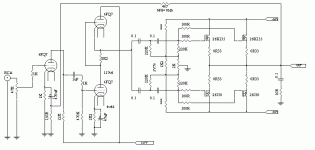I've built this simple SRPP & source-follower hybrid. I have 12 devices (6+6) instead of the 4 devices (2+2) shown in the schematic. I'm thinking I'll need an active device (preferably transistor rather than 6AS7 CF) between the gain stage and output devices to drive the paralleled FET capacitance. Does anyone have advice on driving these 12 devices with the schematic attached?
Attachments
hybrid SEPP driver worth trying (with NPN above, parallel triodes below)
Perhaps replace the top 6FQ7 with a high voltage NPN (or just possibly high voltage N-Ch mosfet) with the bias changed (high value R to B+/2, cap to anode of bottom 6FQ7) and move top 6FQ7 to parallel bottom 6FQ7 (doubling peak output current). This avoids high cathode-filament voltages too. Sonic quality of triode driver will not be changed by NPN in this position since it effectively is constant-current Emitter Follower here, but output Z will be lower. Be careful what happens when gate drive too high - normal zener protection might not be enough on positive peaks with the extra current capability of the driver transistor.
Alternatively, insert an extra voltage-follower stage (Class A, Iq at least 30mA, supply greater than output stage supply rails) between triodes and mosfets, but there can be stability problems with some loads when having too low a driver output impedance when there is a lot of capacitance (better to take a little hit in the -3dB frequency; it is still likely to be pretty high).
Mark
Perhaps replace the top 6FQ7 with a high voltage NPN (or just possibly high voltage N-Ch mosfet) with the bias changed (high value R to B+/2, cap to anode of bottom 6FQ7) and move top 6FQ7 to parallel bottom 6FQ7 (doubling peak output current). This avoids high cathode-filament voltages too. Sonic quality of triode driver will not be changed by NPN in this position since it effectively is constant-current Emitter Follower here, but output Z will be lower. Be careful what happens when gate drive too high - normal zener protection might not be enough on positive peaks with the extra current capability of the driver transistor.
Alternatively, insert an extra voltage-follower stage (Class A, Iq at least 30mA, supply greater than output stage supply rails) between triodes and mosfets, but there can be stability problems with some loads when having too low a driver output impedance when there is a lot of capacitance (better to take a little hit in the -3dB frequency; it is still likely to be pretty high).
Mark
I would add a proper Vbe multiplier bias stage and add an extra driver stage after that.
Over about 0.6A the 2SK135 has a negative temperature coefficient for Vgs, so a normal Vbe multiplier would not match the temperature changes properly, but having some sort of regulation of the bias would be nice. I assume that the present version with 4 devices is working okay, so I only addressed the issue of gate capacitance.
Adding an extra stage isn't necessarily the best way to go if the present version sounds okay with 4 devices... there are several issues to address then: the new drivers have to have their gates/bases protected from too much drive, and they mustn't drive too much current into the zeners built into the output devices, as well as questions over what it does to the linearity and delay (which need not be problems, but having something else to go wrong is something to avoid if we can). But that's still there as an alternative is my first suggestion doesn't go as well as I expect.
Mark
- Status
- This old topic is closed. If you want to reopen this topic, contact a moderator using the "Report Post" button.
